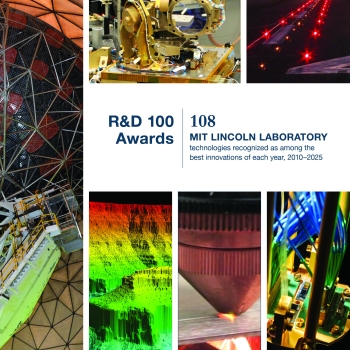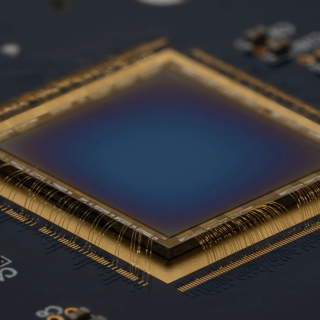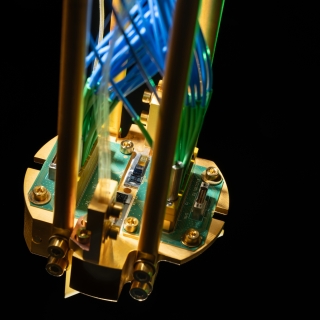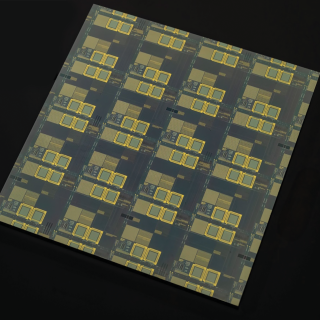
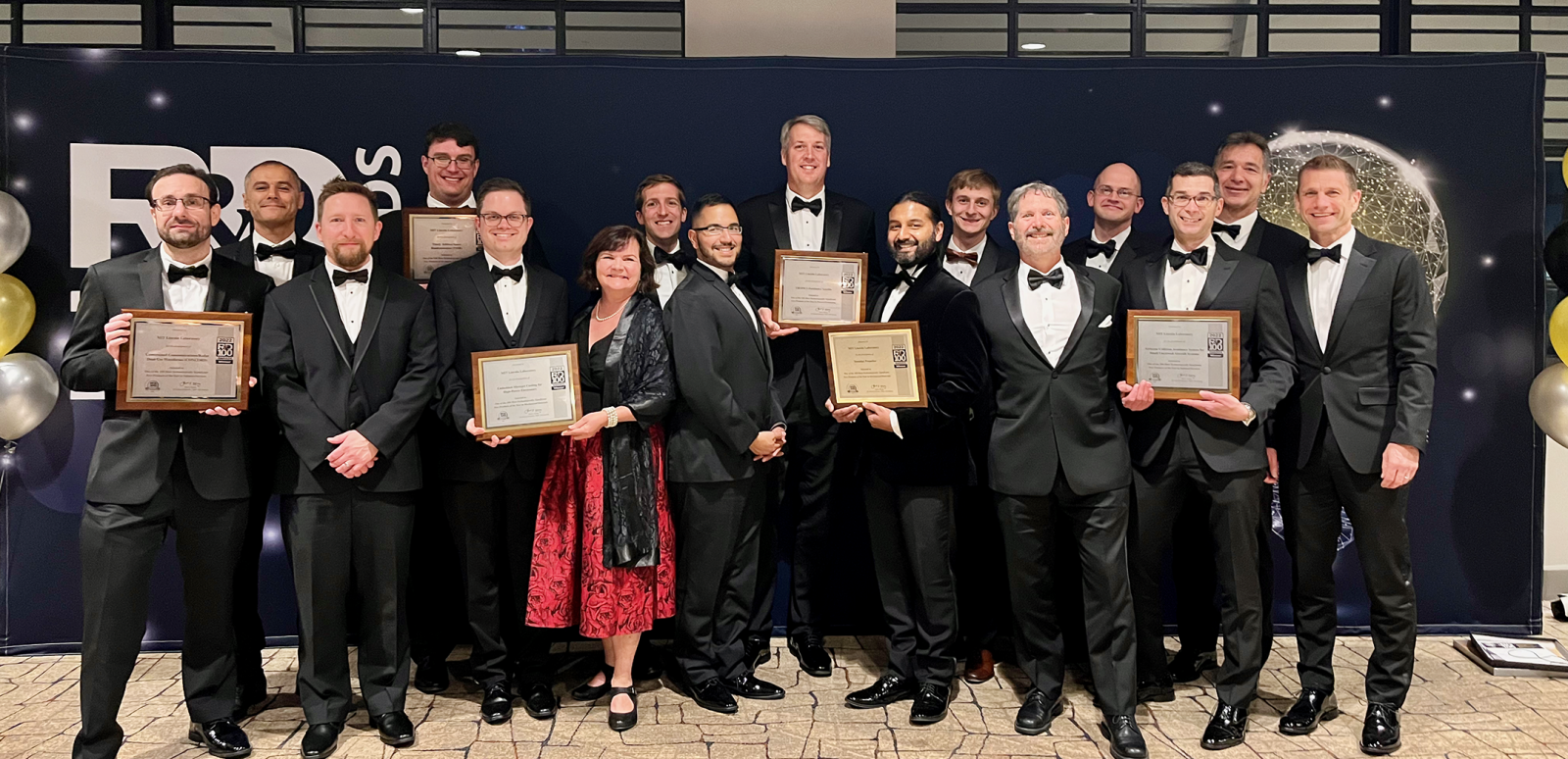
R&D 100 Awards
Our Achievements
Since 2010, Lincoln Laboratory has received 108 R&D 100 Awards, including two R&D 100 Editor's Choice Awards, which are given to the top three technologies from among the year's 100 winners, and a 2023 Silver Medal for Special Recognition in the Market Disruptor category. Presented annually since 1962, the R&D 100 Awards recognize the 100 technology products judged by a panel of technical news editors and outside experts to be the most significant new developments of the year.
R&D 100 Awards Booklet
In this booklet, 108 technologies developed at Lincoln Laboratory are highlighted as recipients of R&D 100 Awards from 2010 to 2025. These awards recognize innovations that may have significant impact on technology advancement in their fields or industries.
Latest News
Technology Transfer Opportunities
Many of our R&D 100 Award-winning technologies listed below are available for technology transfer through our Technology Transfer Office.
R&D 100 Award Winners by Year
2025
- Bumpless Integration of Chiplets to AI-Optimized Fabric — a fabrication approach that enables a 3D circuit integrated with a massive number of specialized chips for improved data-processing speed and power efficiency.
More on Bumpless Integration - Lincoln Laboratory Radio Frequency Situational Awareness Model — a spectrum sensing and classification model that provides users with information on nearby waveforms and their originating devices.
- MAScOT: Modular, Agile, Scalable Optical Terminal — a next-generation laser communications terminal architecture that streamlines technology development with industry partners.
More on MAScOT - Protected Anti-jam Tactical SATCOM (PATS) Key Management System Prototype — a cryptographic server that keeps warfighters connected during satellite communication (SATCOM) terminal rekeying, compromise, or jamming.
- Quantum Diamond Magnetic Cryomicroscope — an instrument that leverages nitrogen-vacancy color centers in diamond to achieve high-sensitivity magnetic field imaging at cryogenic temperatures.
More on Cryomicroscope - TOSSIT: Tactical Optical Spherical Sensor for Interrogating Threats — a baseball-sized chemical sensor that can be thrown or launched into an area to remotely detect hazardous vapors or aerosols.
- WiSPR: Wideband Selective Propagation Radar — a radar that protects U.S. Army armored vehicles from kinetic threats while enabling covert communications.
More on WiSPR
2024
- Autonomous Sparse-Aperture Multibeam Echo Sounder — a very large sonar array, comprising a swarm of autonomous surface vessels, that uses estimation algorithms and acoustic signal processing techniques to rapidly generate high-resolution seabed maps.
More - EYEBOOM — a wearable system that provides early warning of blast-exposure risk for cognitive injury.
More on EYEBOOM - Engineered Substrates for Rapid Advanced Imaging Sensor Development — a fabrication process that dramatically reduces the development time and cost for advanced silicon imaging sensors by enabling a straightforward back-illumination process and uniform thinning on small batches of detectors.
More on engineered substrates - FocusNet — a machine learning architecture that performs context-driven semantic segmentation of airborne ground-mapping lidar data.
- In-Band Full-Duplex Wireless System with Advanced Interference Mitigation — a wireless system that enables the mitigation of multiple interference sources, increasing the number of devices supported, their data rate, and their communications range.
More on the advanced IBFD system - Heat Injury Prevention System (HIPS) — a wearable sensor system that monitors a person's heat injury risk, employing algorithms for estimating body temperature, gait instability, and adaptive physiological strain index
More on HIPS - Low-Temperature Additive Manufacturing of Glass Composites — an approach that uses a direct-ink-writing technique to extrude multimaterial glass ink into a desired form at room temperature.
More on low-temperature AM of glass - Megachip — an approach that interconnects small specialized chips into a single-chip-like monolithic integrated circuit, capable of containing billions of transistors an d reducing latency and energy costs for AI data processing.
More on extremely large-area integrated circuits - Mixture Deconvolution Pipeline for Forensic Investigative Genetic Genealogy — software that allows analysts to decipher forensic samples containing DNA from two contributors without matching them to reference profiles, enabling search in commercial genealogical databases.
- Nanocomposite Inks for 3D Printing Radio-Frequency Devices and Radiation Shielding — a materials system and process that combine a custom-designed active mixing nozzle with specially tailored nanocomposite inks to additively manufacture RF devices with graded dielectric properties.
More on novel nanocomposite inks for 3D printing - Neuron Tracing and Active Learning Environment — an end-to-end software pipeline that generates segmentations of neurons from large brain imaging datasets and allows expert-in-the-loop validation in a web browser to enable semi-automated brain mapping.
More - Portable Aircraft Derived Weather Observation System (PADWOS) — a system that significantly increases the number and quality of real-time wind and temperature observations from aircraft, enabling improved weather forecasts and climate monitoring.
More on PADWOS - Precision Photon Synchronization System for Quantum Networking — the first system that precisely synchronizes photons for long-distance free-space quantum entanglement distribution between different ground sites via an intermediary satellite.
- Superconductive Many-State Memory and Comparison Logic — superconductive circuits that natively store and compare greater than two discrete states, without significantly increasing the number of devices or surface area of the circuits.
- Tunable Knitted Stem Cell Scaffolds — a biocompatible knitted material (scaffold) that advances cell regeneration by mimicking the mechanics of soft tissue to allow more successful stem cell therapy with fewer complications than achieved with current stiff scaffolds.
2023
-
Joint Communication Architecture for Unmanned Systems Security/Cyber Module End Cryptographic Unit — a compact, National Security Agency–certified device that secures tactical datalinks of unmanned systems processing sensitive information
- Noncontact Laser Ultrasound (NCLUS) for Medical Imaging — a portable system that uses an eye-and skin-safe laser to acquire interior images of human tissue without touching the patient
This technology was also the winner of an R&D 100 Silver Medal in the Special Recognition: Market Disruptor category that recognizes entries as game-changing advances in their industries.
More on NCLUS -
Puckboard — a web-based software application that uses artificial intelligence to optimize scheduling of U.S. Air Force aircrews to mission and training flights
More on Puckboard -
Scalable Photonic Quantum Memory Module — a single unit that combines a photonic interface, loss-error correction, and an architecture able to accommodate multiple memory modules to enable high-rate, high-efficiency quantum networking for computing and distributed sensing
2022
- Airborne Collision Avoidance System for Small Unmanned Aircraft Systems — a system designed for the U.S. National Airspace System that can enable small uncrewed aircraft to detect other nearby aircraft and maneuver away to avoid a potential mid-air collision.
- Constrained Communications and Radar Dual-Use — a method of designing waveforms that can be used to simultaneously transmit and receive data while also being used as radar waveforms to detect and track moving objects.
More on the Constrained Communications and Radar Dual Use - Embedded Microjet Cooling for High-Power Electronics — a device that uses arrays of micron-scale fluid jets to drastically improve heat transfer in electronics and allows for closely packed, high-power designs.
- Toroidal Propeller — a closed-form propeller design for commercial unmanned aerial vehicles that is significantly quieter than common multirotor propellers.
More on the Toroidal Propeller - Timely Address Space Randomization — software that prevents a common class of cyberattack by automatically shuffling, or rerandomizing, the location of code in memory.
More on TASR - TROPICS Pathfinder Satellite — a small satellite that uses a novel, miniaturized microwave sounder to provide high-resolution weather data over the Earth’s tropical belt.
More on TROPICS
2021
- Guided Ultrasound Intervention Device — a handheld tool, utilizing real-time AI software, that enables a medic to rapidly and accurately catheterize a central vein or artery in a pre-hospital environment.
More on the Guided Ultrasound Intervention Device - Microhydraulic Motors — a scalable, electrowetting-based actuation platform with a torque density two orders of magnitude higher than that of electric motors.
More on Microhydraulic Motors - Monolithic Fiber Array Launcher — an all-glass, monolithic fiber array launcher that is smaller and more robust than standard arrays.
- Motion Under Rubble Measured Using Radar — a lightweight, portable life-detection radar that rapidly senses, ranges, and characterizes survivors trapped beneath rubble.
More on Motion Under Rubble Measured Using Radar - Spectrally Efficient Digital Logic — a set of digital logic families that operate with intrinsically low electromagnetic interference emissions.
More on Spectrally Efficient Digital Logic - Traffic Flow Impact Tool — a tool for air traffic control managers that predicts and displays impacts to airspace capacities and traffic flow rates during convective weather.
More on the Traffic Flow Impact Tool - Field-Programmable Imaging Array — a universal digital back end for camera systems which, when hybridized to an image detector array, results in a flexible and powerful digital processing system-in-package.
- Free-Space Quantum Network Link Architecture — a system that enables the generation, distribution, and remote interaction of entangled photons across free-space links.
- Global Synthetic Weather Radar — a technology that provides radar-like weather imagery and radar-forward forecasts in global regions where actual weather radar are not deployed or available.
More on the Global Synthetic Weather Radar
2020
-
Cyber Sensing for Power Outage Detection — A system that uses data on internet traffic to rapidly estimate and map the extent and location of power outages across geographic boundaries.
More on Cyber Sensing for Power Outage Detection -
Defensive Wire Routing for Untrusted Integrated Circuit Fabrication — Techniques that deter an outsourced foundry from maliciously tampering with or modifying the security-critical components of a digital circuit design.
More on Defensive Wire Routing -
Forensic Video Exploitation and Analysis — A suite of tools that enables users to efficiently analyze video captured by existing large-scale closed-circuit television systems.
More on Forensic Video Exploitation and Analysis -
Keylime — An open-source key bootstrapping and integrity management software architecture that is designed to increase the security and privacy of Edge, Cloud, and Internet of Things (IoT) devices.
More on Keylime -
Large-scale Vulnerability Addition — A technique that injects numerous bugs into a program at known locations and constructs triggering inputs for each to create ground truth for evaluating bug-finding systems.
More on Large-scale Vulnerability Addition -
Reconnaissance of Influence Operations — A software system that automates the detection of disinformation narratives, networks, and influential actors to address the growing threat posed by adversaries using social media for political objectives.
More on Reconnaissance of Influence Operations -
TeraByte InfraRed Delivery — An optical communications technology that enables error-free transmission of data from satellites in low Earth orbit (LEO) at a rate of 200 gigabits per second.
More on TeraByte InfraRed Delivery -
Timely Randomization Applied to Commodity Executables at Runtime — A technique that protects Windows applications against cyber attacks by automatically and transparently re-randomizing the applications’ sensitive internal data and layout every time an output is generated.
More on Timely Randomization Applied to Commodity Executables at Runtime
2019
- Aperture Level Simultaneous Transmit and Receive Phased Array — an antenna system that allows multiple devices to share a single wireless channel while maintaining high data rates over long ranges.
More on Aperture Level Simultaneous Transmit and Receive Phased Array - Dual-Mode Imaging Receiver — a camera system that can simultaneously capture a wide-field-of-view shot while receiving data from other sources.
More on Dual-Mode Imaging Receiver - Targeted Acoustic Laser Communication — an audio transmitter that sends messages directly to the intended recipient's ear by using laser light.
More on TALC - ArtGut — the first in-vitro device for performing high-resolution, physiologically relevant gut microbiome studies.
More on ArtGut - Mobility and Biomechanics Insert for Load Evaluation (MoBILE) — a biomechanical sensor package worn in a user's shoe and around the ankle for measuring lower leg movement.
More on MoBILE - Gas Mapping LiDAR™ — a sensor that images methane gas leaks and quantifies the leak rates.
More on Gas Mapping LiDAR - Rapid Convective Growth Detector — a software system that detects hazardous storm growth at a rate 10 times faster than ground-based weather systems.
- Visibility Estimation through Image Analytics (VEIA) — a software system that extracts camera data to estimate meteorological visibility for air traffic managers and pilots.
More on VEIA - Tactical Microgrid Standard Open Architecture — an architecture for providing modular, resilient, scalable, and mission-specific power solutions.
- Lightweight Deployable Array Panels for Space — an antenna array panel for satellites that is lighter and more compact than existing technologies. More on Lightweight Deployable Array Panels
2018
- Collaborative Optimization via Apprenticeship Scheduling (COVAS) — an algorithm for performing real-time ship defense for the U.S. Navy.
More on COVAS - Dynamic Flow Isolation — a technique using software-defined networking to minimize unnecessary connectivity between assets on enterprise networks.
More on Dynamic Flow Isolation - FastID and TachysSTR — new algorithms for comparing DNA samples against large datasets of reference profiles.
More on FastID and TachysSTR - Immersive Imaging System — a wide-area video surveillance system for providing very high-resolution images and 360-degree coverage from a single vantage point, monitoring an area equivalent to that of seven football fields.
- Intelligent Power Distribution (IPD) — a new device allowing soldiers to interactively monitor power systems and coordinate energy resources and loads so that mission-critical systems are maintained.
- Multi-rate Differential Phase Shift Keying Optical Communications — a technique for enabling efficient free-space laser communications over a wide range of data rates by using a single easy-to-implement transmitter and receiver design.
More on Multi-rate DPSK Optical Comm - Peregrine: Network Navigation — a system enabling navigation in places where GPS is unavailable, particularly indoors.
More on Peregrine - Photonic Lantern Adaptive Spatial Mode Control — an optical fiber device for providing the ability to adapt a laser beam in the presence of optical turbulence and disturbances.
More on Photonic Lantern for Lasercom - Very Large-Scale Integration Process for Superconducting Electronics — a new process for making circuits faster and more energy efficient than semiconductor-based technologies.
- Web-based HURREVAC — a web-based platform for helping emergency managers to make timely and accurate hurricane evacuation decisions.
More on HURREVAC
2017
- CO2/O2 Breath and Respiration Analyzer — a wireless, low-cost sensor that determines from a person's breath the fraction of metabolic energy produced by carbohydrate versus fat oxidation, providing information to guide weight loss and training.
- Ground-Based Sense-and-Avoid System for Unmanned Aircraft Systems — a first-in-production ground radar system that enables unmanned aircraft to see and avoid other aircraft.
- Polarimetric Co-location Layering — a novel algorithm that leverages polarimetry in maritime radar to mitigate the high false-alarm rate caused by radar returns from the sea surface.
- Presymptomatic Agent Exposure Detection — an algorithm that exploits data from noninvasive wearable medical sensors to detect if a person had been exposed to viruses or bacteria several days before overt symptoms, such as fever, appear.
- Pulse-to-Pulse Phase Diversity Processing for Interference Suppression and Range Disambiguation — a low-cost technique that uses phase-diverse waveforms and specialized processing to help mitigate the interference that wind turbines can impose on radars that track aircraft and weather.
- Wide-Area Infrared System for Persistent Surveillance — a portable system that detects and alerts operators to all moving objects in a monitored area during both day and night surveillance.
2016
- Airborne Collision Avoidance System for Unmanned Aircraft — a system that processes multisensor data to allow unmanned aircraft to detect and track nearby aircraft and to enable ground operators to direct safe separation between unmanned vehicles and other air traffic.
- Offshore Precipitation Capability — a system that provides weather information for air traffic controllers by generating "radar-like" depictions of storms in offshore regions that are outside radar coverage.
More on Offshore Precipitation Capability - Small Airport Surveillance Sensor — a low-cost secondary surveillance system that provides airport tower controllers with situational awareness of aircraft on the airport surface and in nearby airspace.
MORE ON SMALL AIRPORT SURVEILLANCE SENSOR - EnteroPhone™ — a wireless, ingestible device that monitors heart and breathing rates by listening to the body's sounds and that senses core temperature, all from within the gastrointestinal tract.
MORE ON ENTEROPHONETM - Laserscope — a tool set that offers surgical navigation and precise laser targeting within the spinal cavity to enable treatment of back pain with an outpatient procedure instead of with open back surgery.
- Broadband Magnetometry and Temperature Sensing with a Light-Trapping Diamond Waveguide — an ultrasensitive magnetic-field detector and temperature sensor that is 1000 times more energy-efficient than previous diamond-based magnetometers.
2015
- Platform for Architecture-Neutral Dynamic Analysis — an open-source, plug-in software analysis framework that enables computer engineers to observe code as a program executes so they can understand and mitigate vulnerabilities or faults in the code.
MORE ON PLATFORM FOR ARCHITECTURE-NEUTRAL DYNAMIC ANALYSIS - Self-Defense Distributed Engagement Coordinator — an automated decision support tool that guides naval personnel on how to efficiently allocate resources in response to anti-ship missile threats.
- Video Content Summarization Tool — a software application that creates summary views of long-duration surveillance videos so analysts can quickly identify activity of interest.
2014
- Airborne Sense-and-Avoid Radar Panel — a novel stepped-notch antenna array that supports aircraft and weather detection and tracking modes in a single multifunction aperture.
- Curled Microelectromechanical Switch — a curled-electrode switch that eliminates the sticking and contamination issues inherent in traditional electromechanical switches.
- Haystack Ultrawideband Satellite Imaging Radar (HUSIR) — a ground-based, dual X- and W-band sensor that can produce very-high-resolution images of objects orbiting Earth.
More on HUSIR - Localizing Ground-Penetrating Radar — a robust sensor that provides highly accurate, real-time vehicular position estimates based on prior mapping of subsurface features.
- Lunar Laser Communication System — an optical system that achieves very high uplink and downlink data rates between an Earth terminal and a distant satellite.
More on the Lunar Laser Communication System - Wide-Area Chemical Sensor — a highly precise, self-referencing spectrometer that measures the concentrations of specified target gases within the atmosphere.
2013
- The Photoacoustic Sensing of Explosives — a system that detects and discriminates trace amounts of explosives from significant standoff distances.
- The Structured Knowledge Space — a software and information system that enables analysts to mine the vast store of intelligence reports available to government decision makers.
2012
- Lincoln Open Cryptographic Key Management Architecture — a highly portable software library that enables cryptographic protection for communication devices.
- Route Availability Planning Tool — an automated decision support tool that predicts the availability of air traffic routes during thunderstorms.
- Wavelength Beam-Combining Fiber-Coupled Diode Laser — a high-intensity diode laser that combines unprecedented brightness, efficiency, and reliability.
- Wide Field-of-View Curved Focal Plane Array — a curved, charge-coupled device that corrects for inherent aberrations of the mirrors and lenses in optical systems.
More on Wide Field-of-View Curved Focal Plane Array
2011
- Airborne Ladar Imaging Research Testbed — an airborne laser radar that rapidly collects high-resolution three-dimensional imagery of wide-area terrains.
- Multifunction Phased Array Radar Panel — a panel of phased arrays that exploits dual polarization and digital beamforming to provide efficient radar detection and tracking of aircraft and weather targets.
- Parallel Vector Tile Optimizing Library — a real-time signal processing library that enables cross-platform portability of programs without sacrificing high performance.
- Pathogen Analyzer for Threatening Environmental Releases Bioaerosol Identification System — a highly sensitive sensor that uses genetically modified white blood cells to rapidly detect and identify pathogens and toxins.
2010
- Geiger-Mode Avalanche Photodiode Detector Focal-Plane Arrays — a two-dimensional array of ultrasensitive solid-state photodetectors, each of which can measure the arrival time of single photons.
- Subwavelength-Separated Superconducting Nanowire Single-Photon Detector Arrays — a component in an optical detection system that enables broadband single-photon detection with high efficiency and low noise at rates exceeding one billion photons per second.
- Digital-Pixel Focal-Plane Array — a complementary metal-oxide semiconductor readout-integrated circuit for infrared imaging that is capable of an extreme dynamic range.
- Runway Status Lights — a system integrating data from airport surveillance sources to control in-pavement lights that directly alert pilots to potential runway incursions.
- Miniaturized Radio-Frequency Four-Channel Receiver — the smallest, least-power-demanding receiver that can detect frequencies over a six-octave range.
Earlier R&D 100 Award Winners
In addition, Lincoln Laboratory received two earlier R&D 100 Awards: one in 1998 jointly with Cyra Technologies and the Los Alamos National Laboratory for a three-dimensional laser mapping and imaging system; the other in 1995 for a technology that determines a plane's position by using GPS.
